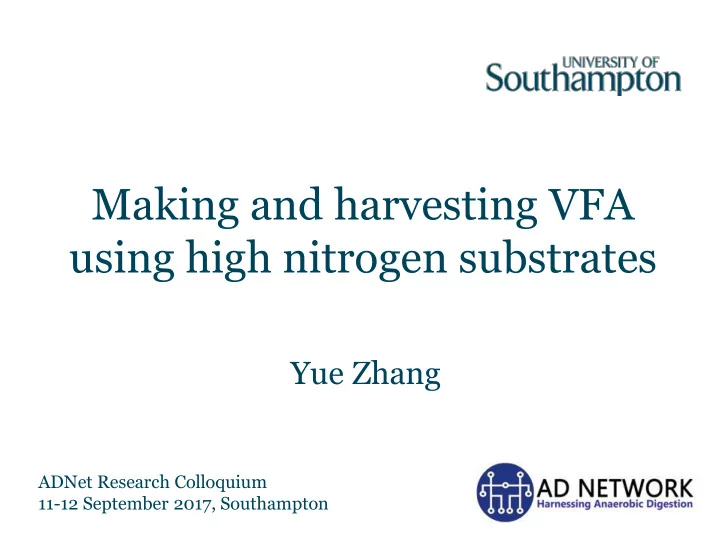

Making and harvesting VFA using high nitrogen substrates Yue Zhang ADNet Research Colloquium 11-12 September 2017, Southampton 1
Content • Context VFA/carboxylate platform Previous laboratory experience ADNet PoC 2014016: production and extraction of C3 and • C4 aliphatic carboxylic acids from the anaerobic digestion of waste blood as a model substrate Results Reflection The next step • 2
VFA/carboxylate platform • Volatile fatty acids (VFA) serve as platform molecules for the production of chemicals and polymers from organic waste streams • Recalcitrant materials: gasification & syngas fermentation Independent of CO:CO 2 :H 2 ratios Tolerant to gasification by-products, e.g. NH 3 , NO x , H 2 S Putrescible materials: direct fermentation • Microorganisms for VFA fermentation are naturally abundant 3
VFA/carboxylate platform • Alcohol production via VFA platform vs direct production VFA production does not require sterile conditions No external enzymes are required to carry out the hydrolysis step All biodegradable organic wastes can be used for VFA production 4
Previous studies 16000 Acetic Propionic Iso-Butyric n-Butyric 14000 Iso-Valeric n-Valeric 12000 FW 1 VFA profile (mg l -1 ) Hexanoic Heptanoic 10000 8000 6000 4000 2000 0 0 50 100 150 200 250 300 Time (days) • The high nitrogen content of substrates results in a high digester total ammonia nitrogen and this can lead to raised concentrations of VFA, and in particular of propionic acid. 5
High nitrogen substrates • High ammonia content Methanogen inhibitor High buffering capacity, no need to add base solution for pH control • Rich in nutrients Again, minimal input of chemicals Waste blood chosen as a model substrate • Readily available No need for particle size reduction 6
Experiments • Open culture fermentation Operational modes: batch, fed-batch, semi-continuous Methanogen inhibitor Enzymatic pretreatment • Recovery Esterification Membrane based solvent extraction 7
Results – VFA production Semi-continuous test Fed-batch test • Due to high ammonia concentration in fermentation broth, a range of high VFA concentration up to 100 g L -1 was achieved with a blood VS of 13.5%, without addition of external methanogen inhibitor. • In general, acetic, n-butyric and iso-valeric acids were the dominant species, although different operational conditions affected the VFA concentration, profile, production rate and yield. • 70-90% of the population was from the Clostridiales order with a large participation from the Sporanaerobacter genus. 8
Results – Esterification Waste blood H 2 SO 4 Methanol Mixed culture Biomass water VFA-methyl Acidification Esterification fermentation removal removal esters Biomass water (NH 4 ) 2 SO 4 9
Results – Membrane based extraction Waste blood Octanol-TOA/VFA Mixed culture Biomass Membrane based VFA VFA fermentation removal solvent extraction recovery Octanol Biomass -TOA Water/VFA 10
Amino acid contents of blood Reference: Kramer S.L., Waibel P.E., Behrends B.R. and El Kandelgy S.M. (1978) Amino acids in commercially produced blood meals. J. Agric. Food Chem. 26, 979-981. 11
Amino acid fermentation References: 12 Ramsay I.R. and Pullammanappallil P.C. (2001) Protein degradation during anaerobic wastewater treatment: derivation of stoichiometry. Biodegradation 12: 247-256. Schönheit P., Buckel W. and Martin W.F. (2016) On the origin of heterotrophy. Trends in microbiology 24: 12-25.
Previous studies - revisit 16000 Acetic Propionic Iso-Butyric n-Butyric 14000 Iso-Valeric n-Valeric 12000 FW 1 VFA profile (mg l -1 ) Hexanoic Heptanoic 10000 Selective propionic acid 8000 production, but: 6000 • 100 mg HPr L -1 day -1 4000 • ~5% of VS 2000 0 0 50 100 150 200 250 300 Time (days) • Other VFA was degraded to biogas; propionic acid has the slowest degradation rate 13
VFA/carboxylate platform • Alcohol production via VFA platform vs direct production VFA production does not require sterile conditions All biodegradable organic wastes can be used for VFA production No external enzymes are required to carry out the hydrolysis step Challenges • Selectivity Solids in the effluent 14
Follow up Solids Liquor High nitrogen Leach-bed Selective VFA Anaerobic Biogas substrates fermenter extraction digestion VFA, Digestate Other chemicals An additional unit? • Chain elongation • BES 15
Acknowledgements Thanks to Anaerobic Digestion Network PoC 2014016 Dr Jersson Plácido … and to Newton Fund Institutional Links and AD Network for continuing support to take this work forward Miss Victoria Outram Mrs Jing Lu 16
Recommend
More recommend